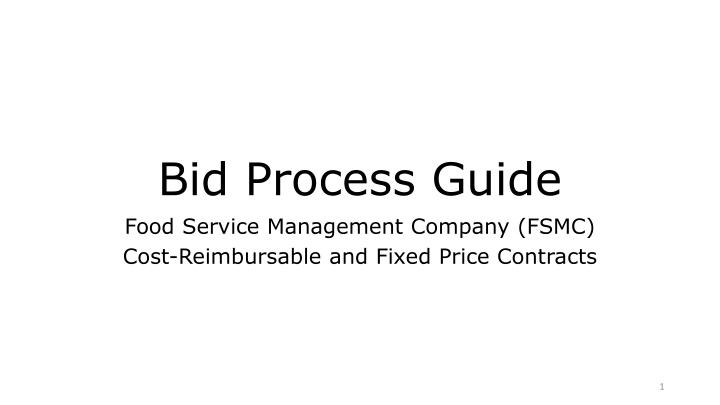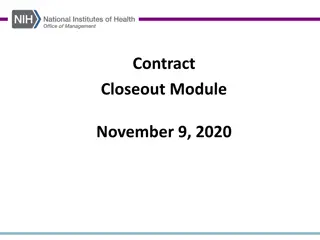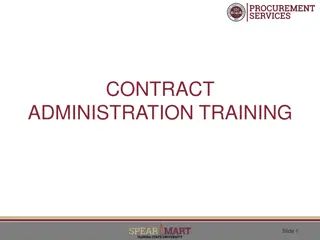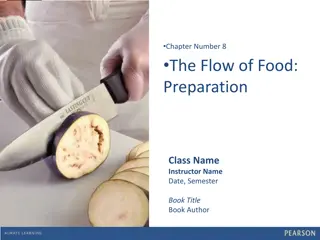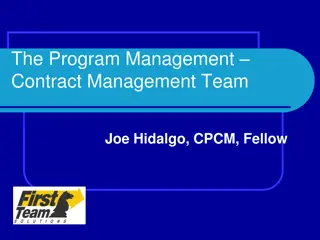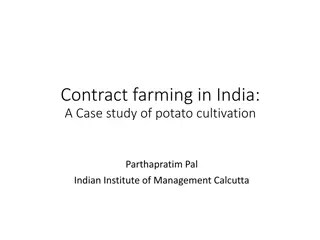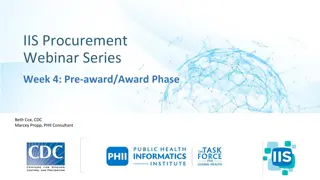Best Practices for Food Service Management Company (FSMC) Contract Administration
Effective contract administration and monitoring are crucial for ensuring the success of food service management company contracts in the food service industry. Regular communication, meticulous monitoring, timely payment, and adherence to contract terms are key components in maintaining program integrity and achieving operational success. Additionally, understanding the contract, monitoring service delivery, and enforcing compliance are essential steps for a seamless contract administration process.
Download Presentation

Please find below an Image/Link to download the presentation.
The content on the website is provided AS IS for your information and personal use only. It may not be sold, licensed, or shared on other websites without obtaining consent from the author.If you encounter any issues during the download, it is possible that the publisher has removed the file from their server.
You are allowed to download the files provided on this website for personal or commercial use, subject to the condition that they are used lawfully. All files are the property of their respective owners.
The content on the website is provided AS IS for your information and personal use only. It may not be sold, licensed, or shared on other websites without obtaining consent from the author.
E N D
Presentation Transcript
Bid Process Guide Food Service Management Company (FSMC) Cost-Reimbursable and Fixed Price Contracts 1
Contract Administration and Monitoring Before entering into any contract, it is important to note that the district s responsibilities do not end when the contract is signed. Monitoring the contract is essential to ensure the service procured is the service received, that the SFA receives the full value of purchase discounts and rebates, and to ensure there is compliance with Federal law. The district s diligence in monitoring the contract helps demonstrate program integrity, fiscal responsibility, and is key in protecting the district s interests. The district and the FSMC owe it to one another to regularly and clearly communicate about service. Both parties should notify each other of service issues, work on resolutions, and discuss what is working well and what isn t. This will help everyone achieve success. 2
Know it, Monitor it, Communicate! Know the contract. Read and understand what is included in the contract. Monitor the service. Check that meals served match menus, are reimbursable, and meet food quality standards. Check invoices to ensure accuracy and that costs are allowable. Communicate with the FSMC. Question discrepancies. Ensure terms are met. Resolve issues and complaints. Enforce the contract. 3
Pay Invoices on Time Timely payment to FSMCs for reimbursable meals and compliant service is critical to the success of the program just as much as it is to the FSMC s successful operation. Consistent failure to pay FSMCs on time may negatively impact their ability to provide successful service to the district or even elsewhere. 4
Monitor the Service Monitoring the contract is essential to ensure: The service procured is the service received. Compliance with Federal law. SFA receives the full value of USDA food credits. SFA receives the full value of purchase discounts and rebates (cost-reimbursable contracts only). The district s diligence in monitoring the contract helps: Demonstrate program integrity. Demonstrate fiscal responsibility. Protect the district s interests. 5
Contract Duration All contracts run from July 1 of the current year to June 30 of the following year. Per Federal regulations, contracts run for one year with the option of four one-year term renewals. It is recommended that bid proposal documents be sent to MDE between November and February to give enough time for review and approval before the July 1 deadline. 6
Cost Reimbursable vs. Fixed Price Contracts Determine which Food Service Management Company (FSMC) contract is most appropriate for the district: Cost Reimbursable contracts provide for the payment of allowable costs incurred by the FSMC while performing the contract. Companies are reimbursed at the value of the allowed expenses plus may also be paid a fixed management and administrative fee to perform these services. Fixed Price contracts provide a stated fixed price per meal without any upward or downward adjustment during the duration of the contract. This type of contract may allow FSMCs to adjust the fixed price per meal according to the Consumer Price Index as identified in the original solicitation. 7
Bid Proposal Packet Four documents make up the initial packet to MDE: Legal Notice Letter to Food Service Management Companies (FSMCs) Request for Proposal (RFP) Information Section (with applicable policies and menus) Bid proposal packets must be submitted to MDE for review at least three to four weeks in advance of the pre-bid meeting. This is recommended, but MDE understands that situations may arise where a shorter timeline is needed. Contact MDE to discuss timelines. 8
Bid Evaluation Committee Before going out to bid, a bid evaluation committee must be assigned to participate throughout the entire bid process. There is no minimum or set number of committee members required, but the same committee members must attend and participate in the entire bid process, such as during the pre-bid meeting, bidder presentations, and when evaluating the bids. It is at the district s discretion who will be involved on the committee or which roles committee members play within the district. Committee members should not have a personal financial interest in the bid award or have any other legal or financial conflict of interest. 9
Unallowable Provisions and Overly Responsive Items The FSMC bid proposal may not include unallowable cost items such as scholarships, incentives, gifts, travel packages, football signs, vacations, kitchen equipment, special events, or other overly responsive items. These types of items are outside of the scope of the solicitation and create a conflict of interest. They must not be included in the evaluation and scoring to determine contract award. If included, these types of items may disqualify and render the entire FSMC response ineligible for contract award. 10
Bid Protest Policy or Procedure Per Federal procurement procedures found under 2 CFR 200.318(k), the SFA alone is responsible, in accordance with good administrative practice and sound business judgement, for the settlement of all contractual and administrative issues arising out of its procurement. Issues may include, but are not limited to, source evaluation, disputes, protests, and claims. Bid protests will go directly to the district for resolution. Therefore, it would be best practice for the SFA to have a policy or, at the very least, a procedure in place to handle and resolve disputes relating to its procurements. 11
Pre-Bid Meeting Attendance by interested bidders at the pre-bid meeting is required. The district must provide a sign-in sheet for attendees of the pre-bid meeting and include in the final packet to MDE. The following may occur at the pre-bid meeting: Release of bid (distribution of prepared copies). Review specifications. Answer questions as a group. Conduct a walk-through of facilities. The pre-bid meeting is NOT the time for individual conversations with the companies. 12
Legal Notice and Letter to FSMCs After MDE approval: Publish the approved Legal Notice in a widely read newspaper seven to ten days in advance of the pre-bid meeting date. Email the approved Letter to FSMCs as a mass email with the Letter attached. Send the Letter to AT LEAST ALL of the companies on MDE s courtesy list. The district may also send the Letter to any other entities not included on MDE s courtesy list. Do not blind copy recipients; instead, include all email addresses in the To line of the email. CC your assigned MDE analyst on all correspondence between the district and the companies. 13
As a reminder: The SFA may not advertise or distribute bid packet materials without MDE s prior review and written approval. 14
Request for Proposal (RFP) It is required that districts use the RFP prototype Word document provided by MDE. Additions or changes to the prototype documents are allowable but must be in bolded red font so they are clear for MDE review. Complete the Attestation Sheet, making sure to add the district s name along with the pre-bid meeting date. Districts must fully review and read all sections of the entire RFP. It is recommended the district consults with its legal counsel to ensure interests are covered. 15
RFP Contract Terms (Section E) This section discusses the renegotiation of fees in subsequent years of the contract. Renegotiated fees must not exceed the current CPI rate or a flat percentage rate as determined by the district and noted in this section. At the renewal stage, the lesser of the two rates will be the percentage the fees may increase that year. Note: Inserting 0% for the flat percentage rate is allowed, but is not necessarily best practice. FSMCs rely on this minimal increase to account for increases in operational and administrative costs, such as gas and food. The district should consider how much it can afford as an increase each year of the contract. 16
RFP Manager/Employees (Section J & K) Select all options that apply and delete those that do not apply in these two sections for managers and employees. If a district will be sharing a manager with another district, both districts must go out to bid together on the same cycle. Multiple plans (such as Plan A, Plan B, etc.) are acceptable. Each bid plan must have a separate bid sheet in the Information Section. 17
RFP Guaranteed Return (Section O) If the district requests a guaranteed return, insert a dollar amount in this section - it is okay to enter break even, no loss, or zero instead of a dollar amount. Pay special attention to addenda included in the proposals. MDE does not approve addenda on the district s behalf. The district MUST review, understand, revise, reject, or accept any addendum. It is recommended that the district consults with its legal counsel regarding any addendum. 18
RFP Professional Standards (Section Q) Questions regarding the implementation of the Professional Standards Final Rule should be directed to the School Nutrition Programs office (517-241-5374). 19
RFP Meals (Part VI, Section E) Districts might not currently participate in a particular meal or program, such as SFSP or CACFP, but may decide they want to add it in the future. If this is the case, leave these in the text as future options, making sure they are also noted as future options on the School District Information meal pages in the Information Section. 20
RFP Monitoring (Part XI) MDE conducts random audits to verify that district reconciliations are completed and accurate. Prior to yearly renewal approval by MDE, the district must sign an Acknowledgement for Contract Renewals document acknowledging that invoice reconciliations are being conducted internally. Refer to Administrative Policy Memo #3 for School Year 2015- 2016 on the Food Service Contracts website for more information. 21
Please note: All changes to the RFP are subject to MDE approval. Districts must obtain MDE approval prior to releasing any revised documents. 22
Information Section The Information Section is an Excel document with pre-filled formulas in many areas and the totals transfer to other areas throughout the document. 23
SFA Policies The SFA must attach the following: Procurement Policy to include: Written code of conduct District s small purchase threshold Bid protest procedures Meal Charging Policy, which may address humanitarian/alternate meals Bad Debt Policy 24
Bid Point Calculator The Bid Point Calculator is the tool used by the district to evaluate the bids submitted by FSMCs. The company with the highest points, after price and non-price criteria are evaluated, is the winner of the bid award. Tab 3 gives suggested non-price criteria and sub-criteria for districts to enter on the Bid Point Calculator. Districts are not required to use these suggestions. They are only provided as examples. Tab 4 is a sample Bid Point Calculator as it should look upon submission as part of the bid packet. This sample is provided as guidance for formatting the Bid Point Calculator. Note: Tabs 3 and 4 may be deleted from the Information Section prior to submitting it to MDE as part of the bid packet. 25
Bid Point Calculator cont. Please note: If the district intends to use taste tests or menu sampling as a part of its decision, that should be included as a part of the non-price criteria on the Bid Point Calculator. 26
SFA Staffing Patterns All current SFA food service employees should be entered on this page. Insert each employee for each building, job titles, hours they worked, and what their annual total wages were for the last school year. If a district is self-op, the Food Service Manager should also be included on this page. 27
FSMC Staffing Patterns All FSMC employees are noted on this page. For each school building, enter each employee, job title, and the number of hours worked over the last school year. Mark an X indicating if the employee s compensation includes items in columns D-J. If the district shares a food service manager with another district, it will be noted here on this page. Note how many hours the manager works in your specific district and which district is sharing the manager. Note: If a district uses its own SFA employees but has a FSMC food service manager, the only position listed on this page will be the FSMC food service manager. All other SFA employees will be listed on the SFA Staffing Patterns page. 28
Proposed Staffing Patterns by FSMC FSMC completes this page as part of their bid proposal to indicate proposed staffing patterns. 29
Projected Cost Information This tab should be an accurate picture of the district s overall expenditures in its food service account. At the top of the page, fill in how many days of service there were in the previous school year. Fill in each line item to be included in the bid pricing. Describe the expenses for Contracted Services and any amount noted on the line for Other. Notes can be added to the bottom of the page if needed. 30
Equipment Inventory List List food service equipment in column A and mark whether the item is considered expendable or non-expendable, and whether it is provided by the SFA or the FSMC. 31
USDA Foods Attach the SY 2017-2018 year-end PAL report (obtain from your consortia s website). Identify the SY 2019-2020 consortia election made on the SY 2018-2019 application in MEGS+. List the SY 2017-2018 annual delivery fee amount. Indicate any major changes that took place in the district between SY 2017-2018 and SY 2018-2019 that might impact USDA Food Entitlement Usage. For example, did your district size increase or decrease significantly? 32
School District Information Pages These pages show the Average Daily Participation (ADP) values for meals served. At the bottom of each page, note which claim month and year that was used to determine the ADP calculations.* List ALL sites participating in each food program.** Fill in the values for enrollment, meal price, average daily participation, and a la carte meals sold. All are monthly totals, with the exception of a la carte, which is a projected yearly total. 33
Average Daily Participation (ADP) Using the claim month as indicated: Divide the total number of meals by the total number of days of food service claimed for that month. For example, if the high school site has 1,000 free meals claimed and there are 21 days of food service claimed for the month, the following applies: 1,000 free meals 21 serving days = 47.6 ADP Enter 47.6 in the Free column for the high school site 34
Projected Revenue Information Top of page: Enter the total number of days for the upcoming school year expected for each meal and program. Delete meals or programs that are not applicable. Local Revenue: Fill in values for the number of meals sold (which is explained on the next slide) and meal prices charged by SFA where applicable. Federal Reimbursements: Matching the claims, fill in values for only those meals that the district will serve. Do not change the Federal Rates; dollar amount totals will pre-populate based on formulas. Near the bottom of page: Enter the district s 31a, 31d, and 31f state aid payment amounts and the Fresh Fruit Vegetable Program payment amount. Bottom of page: Note the claim month used to calculate values; month should match what was entered on the SDI tabs. A la carte sales must match the amounts entered on the School District Information pages, if applicable. 35
Calculate Number Sold Local Revenue Section Note: Middle and high school are both considered secondary grades if separate from the elementary school. To calculate the number sold: Multiply the appropriate total ADP value found on the SDI meal tabs by the total number of days (noted at top of Revenue Info page). For example, if the total ADP for paid elementary breakfasts is 65 and there will be 180 days where breakfast will be served in the year, the following applies: 65 ADP x 180 serving days = 11,700 paid elementary breakfasts sold Enter 11,700 for Elementary Paid under Local Revenue Breakfast Enter the meal prices charged by the SFA in the Price column for each meal type served (totals calculate automatically). 36
Number Sold Federal Reimbursements Only place number sold values on the lines that apply to the district and match the claims. For example, if the district is not listed as severe need and is not eligible for the extra 6 cents, do not use those lines. Do not change prices under the Federal Rates column. Dollar amount totals calculate automatically. 37
RFP Projected Meals/Meal Equivalents Calculator This tab has formulas, so the cells will automatically populate. Bottom of page: Note claim month used to calculate values; the month should match what was entered on the SDI tabs. 38
RFP SDI Building Demographics Enter each school building, grades, and meal times in appropriate columns. Enter the number of days expected for the upcoming school year for each meal type at each school building. The number of days for the year for each meal should match the number of days that was noted for each meal and program on the top of the Projected Revenue Information page. Bottom of page: List the schools and sites that have vended agreements with the district. One example of a vended agreement would be if the district sells lunches to an outside organization such as a head start, senior citizen center, or charter school. 39
Services by Locations Enter each school building serving meals and place an X in the appropriate column indicating meal types served. An X cannot be placed in both the Full Serve and Offer vs. Serve columns for each meal type. Place an X in one column or the other. Grades 9-12 must have an X in the Offer vs. Serve column. 40
Cost Responsibility Detail Sheet Place an X in the appropriate column indicating the area of responsibility for either the FSMC or the SFA. Note that it is possible for some items to have an X in both the FSMC and SFA columns. It is acceptable to define those items in a note at the bottom of the page. Items marked as the responsibility of the FSMC should match the bid items listed on the Projected Cost Information tab and the Bid Sheet. 41
Claims for Reimbursement MDE will supply claim reimbursement data for the appropriate months as identified by the SFA on the SDI pages. 42
Menus Include sample menus for each meal type served (breakfast, lunch, snack, supper) for each site where meals are served. Menu samples must show 21 days of meals and include milk choices. It is okay to use rotating weekly schedules (but indicate that on the menu). Remove all food service logos and names of staff/directors. It is recommended to not copy and paste the menus into these tabs. Note See attached and include a PDF version of each menu. Sample complete menus with associated meal component tools can be found at: http://education.ohio.gov/Topics/Other-Resources/Food-and- Nutrition/Resources-and-Tools-for-Food-and-Nutrition/Menus-that-Move 43
A la Carte Each FSMC must include its a la carte menu and pricing sheet. 44
Menu Fresh Fruit and Vegetable Program (FFVP) FSMCs must include a cycle menu if the district is participating in the FFVP. 45
Meal Pattern and Food Specifications There is no need to make any changes to this tab, unless there are specific requirements for this district in regards to meals, food, times, etc. Note specific requirements at the bottom of this tab if appropriate. 46
Bid Sheets Bid Sheets are used to outline the specific items FSMCs will be bidding on. There are two different types of Bid Sheets: 1. Without an Advanced Payment 2. With an Advanced Payment Both types of Bid Sheets may be completed if desired. Include extra Bid Sheets for additional plans and note the plan name at the top of each sheet (such as Plan A, Plan B, etc.). 47
Bid Sheets cont. Cost-Reimbursable Contract Enter the district s name at the top of each page. The cell for equivalent meals per year will prepopulate; do not enter a number. Place an X next to each line item the district wishes the FSMC to include in their bid. The line items that are marked with an X must match items noted on the Projected Cost Information page and the Cost Responsibility Detail Sheet. Fixed Price Contract Enter the district s name at the top of each page. The cells for reimbursable meals will prepopulate; do not enter numbers. 48
After the Bid Due Date After bid proposals are received, the bid evaluation committee will: Document that the proposals were received on time. Note that each proposal includes a bid bond. Evaluate the responsiveness of each bid proposal. Evaluate the responsibility of the bidders. Please note: If the district rejects a bid for any reason (for example, if a bid is late or not responsive), the district must have documentation to support the rejection. 49
After the Bid Due Date Interviews and Presentations The district may hold bidder interviews and/or allow presentations after bids are received and evaluated for responsiveness. An invitation must be extended to ALL responsive bidders. All elements must be kept equal, including the same bid evaluation committee members present, length of time of presentations, and questions asked of companies. 50
